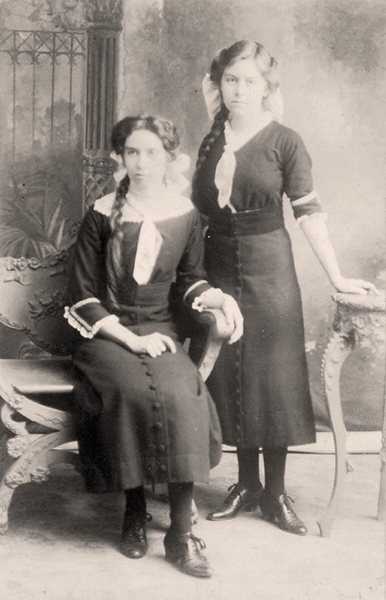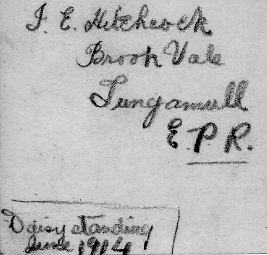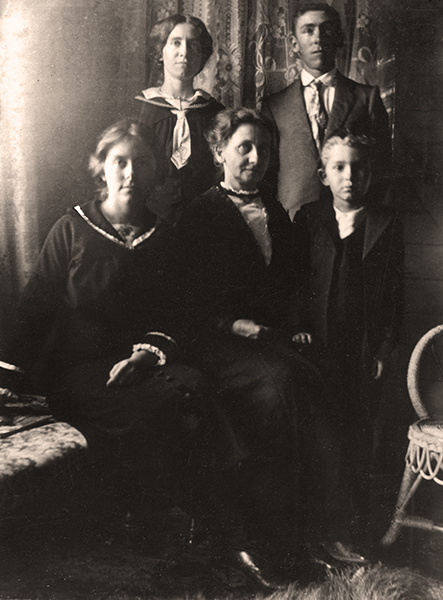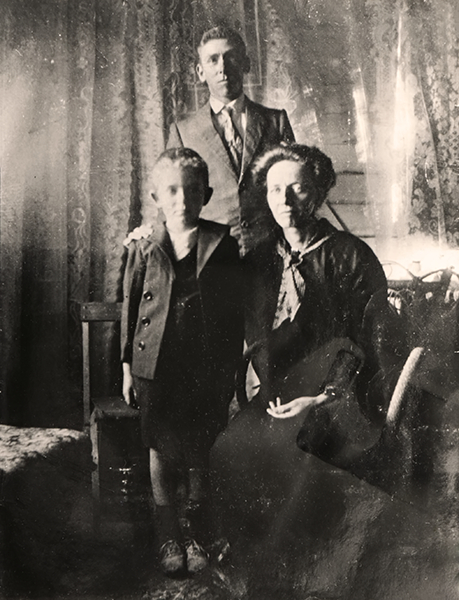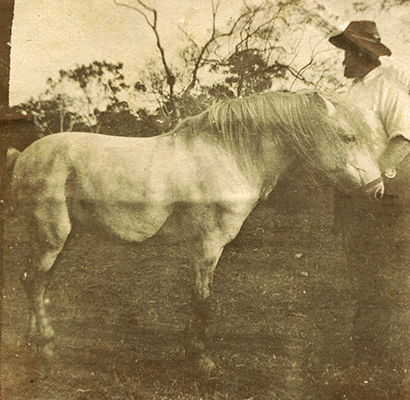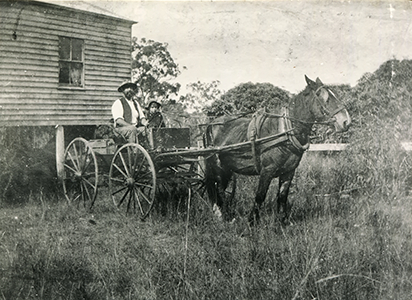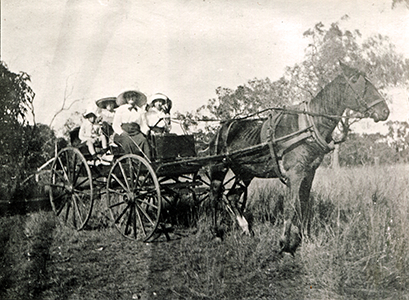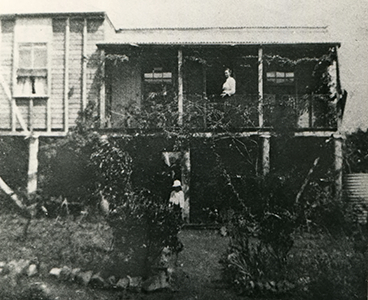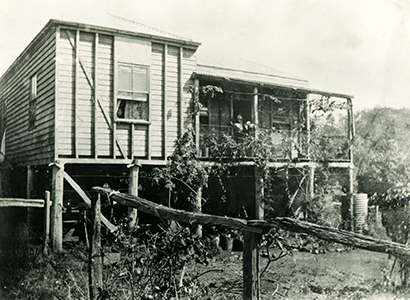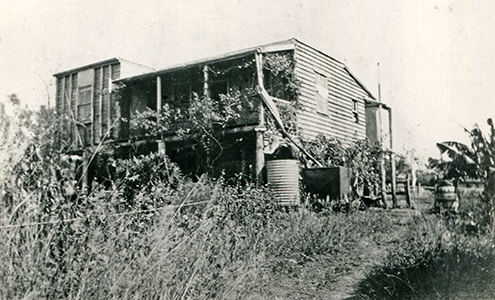Back to Don's Maps
Hitchcock Family History
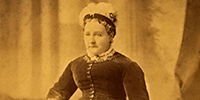 Back to the Hitchcock Family index
Back to the Hitchcock Family index
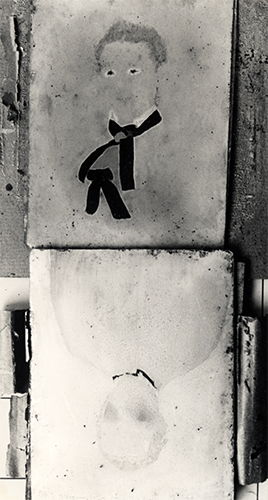
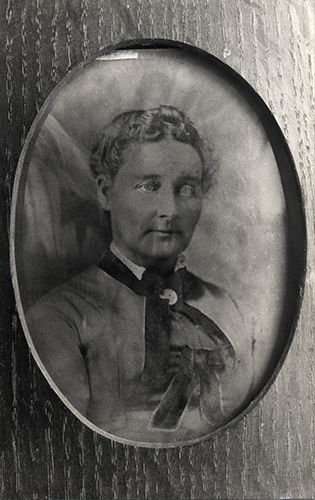
Studio photo of unknown origin of Great Grandmother Emma Hitchcock, nee Fuller, probably taken before she was married, and before leaving England for Australia, which she and her husband reached in 1865.
She had red curly hair. Notice how short it is.
The photo uses a fascinating technique, an adaptation of the Ambrotype process. The negative is on the back of the bowl shaped glass. The eyes and scarf and hair were painted over, with extra tinting on the paper behind, to give the illusion of a positive. The back of the negative is shown at the top of the left hand photo.
Her maiden name was Wright, which gives the name Charles Wright Hitchcock (Uncle Charlie).
Photo: Unknown Studio.
The ambrotype was introduced in the 1850s. During the 1860s it was superseded by the tintype, a similar photograph on thin black-lacquered iron, hard to distinguish from an ambrotype if under glass.
In the classic ambrotype process, one side of a clean glass plate was coated with a thin layer of iodized collodion, then dipped in a silver nitrate solution. The plate was exposed in the camera while still wet. Exposure times varied from five to sixty seconds or more depending on the brightness of the lighting and the speed of the camera lens. The plate was then developed and fixed.
The resulting negative, when viewed by reflected light against a black background, appears to be a positive image: the clear areas look black, and the exposed, opaque areas appear relatively light. This effect was integrated by backing the plate with black velvet; by taking the picture on a plate made of dark reddish-coloured glass (the result was called a ruby ambrotype); or by coating one side of the plate with black varnish.
Either the emulsion side or the bare side could be coated: if the bare side was blackened, the thickness of the glass added a sense of depth to the image. In either case, another plate of glass was put over the fragile emulsion side to protect it, and the whole was mounted in a metal frame and kept in a protective case.
Text: Wikipedia
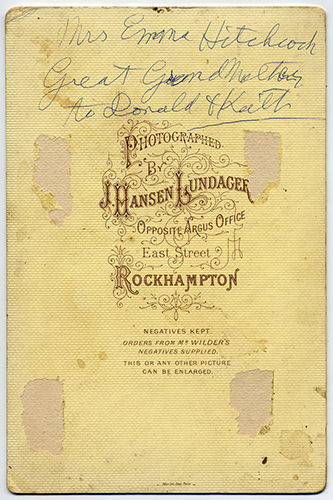
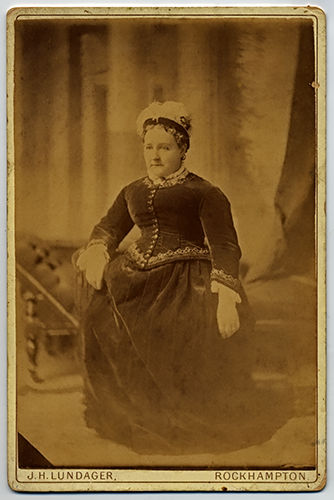
Studio photo ca 1887 of Great Grandmother Emma Hitchcock, nee Fuller.
Boned bodices of this type were popular during 1885-1887, and in 1887 braid trimmed neck and cuffs were popular. In America velvet hats with ostrich feathers were popular in 1884-5, and in 1887 hats in red felt were trimmed with red velvet and feathers.
J. Hansen Lunduger, Photographer of East Street, was at this address between 1884 and 1891. The velvet dress and corsets must have been awfully hot for most of the year in Rockhampton! I wonder if the dress was green to go with her red hair?
On the back, in the handwriting of William Edward (Ted) Hitchcock:
'Mrs Emma Hitchcock Great Grandmother to Donald and Keith'
Photo: J. H. Lundager, Rockhampton
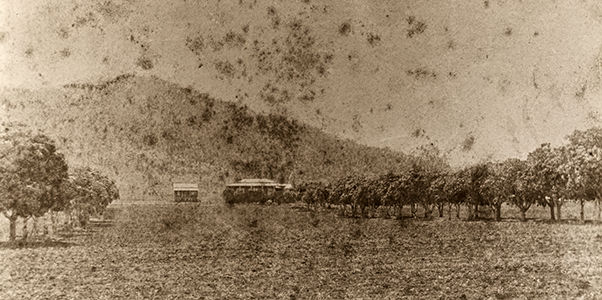
1890?
'Fern Hill' Tungamull (later Tarabah)
Charles William Hitchcock's home. William Henry grew up here. Rod Higginson's parents had it at one time. Note shed on left which is not on later(?) photos. I wonder if it was the original house, since demolished?
Note in particular the double row of mango trees lining the drive up to the house. By the late 20th Century, the trees were huge, and the drive was no more, just a tangled mass of undergrowth. The original house was still standing, but had been clad over the original timber, which was still in good condition.
I remember seeing a photo at one time of macrozamias on a hill side at the farm. They are poisonous to livestock, and Will was forever digging them out. In vain, since there were a great many macrozamias on the property when we visited it much later.
This is probably the origin of the name 'Fern Hill'.
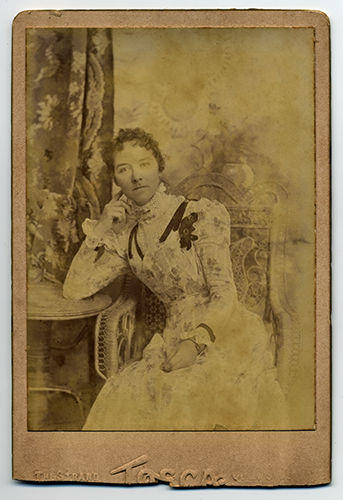
1890-1892?
Great Aunt Sis (Eliza)
Born 18.05.1873 Birth Certificate No. 73/002812
Taken in Rockhampton, 'The Strand Tosca Queensland' is embossed on the card, which is 15.5 x 10.5 cm in total.
Date based on the size of the puffed upper sleeves. The bustle disappeared at about this time, and the silhouette changed to an hour glass figure. The high lace collar was still popular in 1893.
Same background as the 1900 family photograph. Very faded.
Sis was a severe woman with a strict manner. She looked after Great Grandfather until he remarried, to Grace, who was French, and quite young. Some say no one approved of his marriage to Grace, yet others say that she was accepted readily into the family.
Bella thought that Grace thought that Charles had a lot of money.
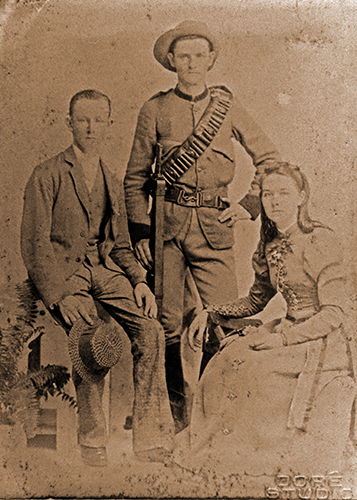
Studio photo, Christmas 1894, left to right:
Great Uncle Ned (Edward Clement), 17 yrs, DOB 07.12.1877
Birth Certificate No. 78/004454(? perhaps birth was registered late?)
(jeweller who later died of pneumonia fairly young)
Great Uncle Dick (Richard Alfred), 19 yrs, DOB 25.08.1875
Birth Certificate No. 75/003405
(Turner by trade, later in Queensland Railways)
Great Aunt Sis (Eliza), 21 yrs, DOB 18.05.1873
Birth Certificate No. 75/002812
(later a nurse, she married Bill Ferguson)
Brothers and sister of William Henry Hitchcock
These were the single members of their generation, William Henry and Charles were married by this time, W.H. in 1893, Charles in 1894.
Note uniform on Dick. The Boer War was in 1881 and again in 1899.
Photo: P. M. Walker, Doré Studios, Rockhampton.
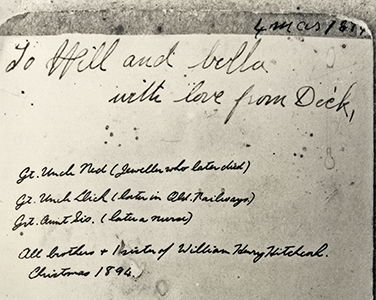
Writing on back by Dick, and later by Keith Hitchcock.
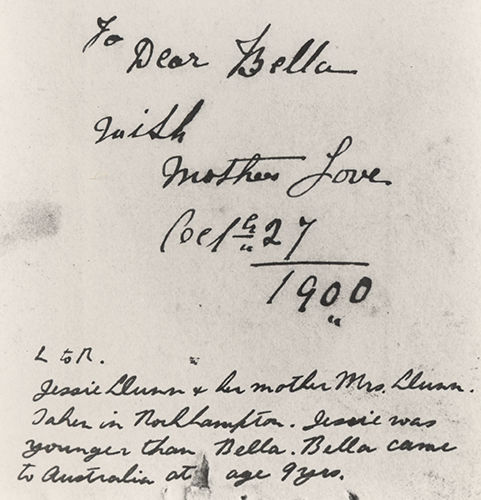
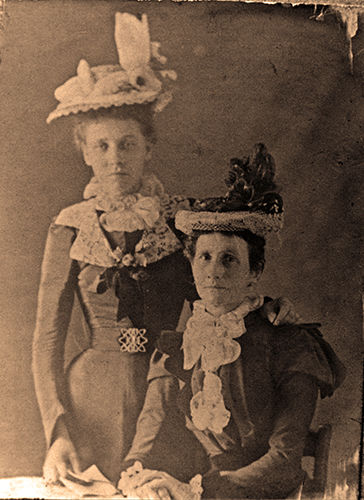
'To Dear Bella With Mothers Love Octbr 27 1900'
Taken in Rockhampton. Jessie appears to be wearing a corset, which would have been normal at that time.
Jessie was Bella's younger sister - looks about 17. Jessie thus born about 1883, in Rockhampton (?)
Mrs Dunn looks about 50, thus born 1850 (?)
Bella came out to Australia from Scotland at age 9 years. Bella born 1872 (?) came out in 1881 (?)
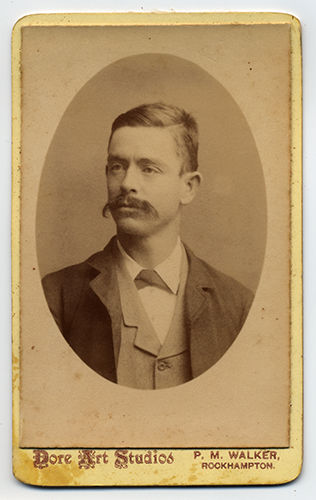
1900?
Great Uncle Dick (Richard Alfred)
Born 25.08.1875 #75/003405
Studio Carte de Visite type.
Playing card size.
In 1899 he lived with his father at Bolsover St between Archer and Cambridge Streets, Occupation Turner (Electoral Roll district of Rockhampton 03.07.1899)
Photo: Dore Art Studios, P. M. Walker, Rockhampton.
Note that the original Doré Art Studios had dropped the e acute in their name by this time, compared with the 1894 photo of Ned, Dick and Sis.
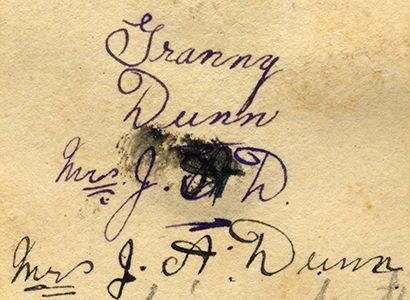
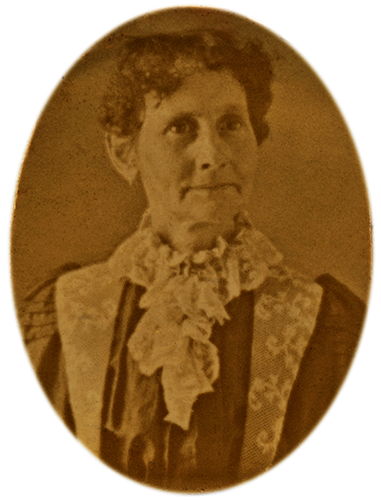
Granny Dunn 1907?
Mrs John A. Dunn (nee Jessie Ann Wright)
Migrated to Australia from Scotland about 1882, with her husband and children Bessie, Jessie, and a son.
Hazel: "Jessie and Bella had a brother, and he lived in Rockhampton at one time."
Madge's Grandmother Dunn.
Inscription in purple ink:
'Granny Dunn
Mrs J. A. Dunn'
Looks like the same print run as Kenneth Ray 1907 and same handwriting - William Henry Hitchcock
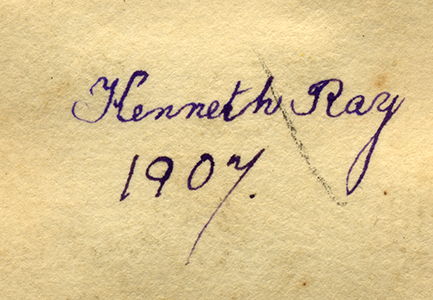
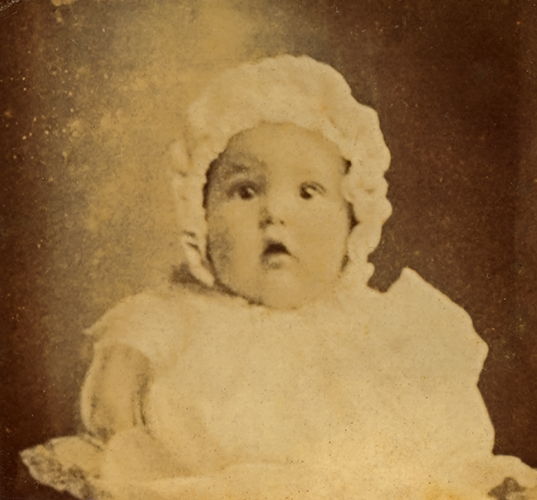
Inscription in purple ink: 'Kenneth Ray 1907'
This would have been a flash photograph, using magnesium powder ignited in a holder. A lovely surprised expression. The only way at the time to get a photo of a lively baby who could not be expected to sit still for long.
But Kenneth Ray who? A friend of the family? A Hitchcock?
Looks like the same print run as, and same handwriting as the Granny Dunn photo - William Henry Hitchcock.

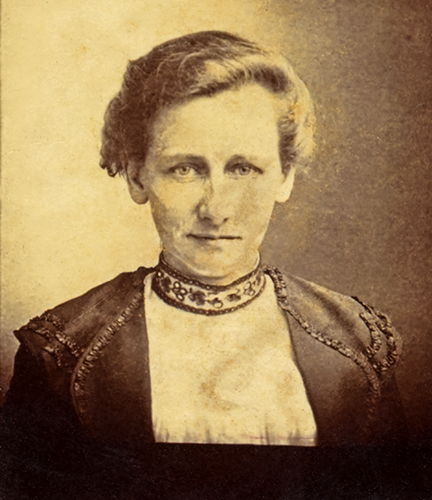
Bella, 20.03.1908
Inscription: 'To Betty with love from Mother March 20th 1908'
This photograph was taken when Bella was 5 months pregnant with Teddy.

Bella, 20.03.1908
A copy of the photo above was put into this tin frame.
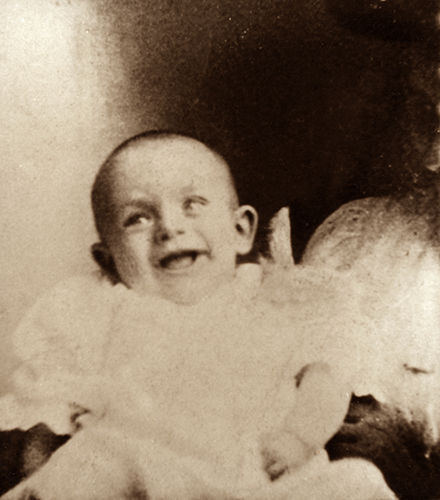
Earliest photo of Teddy, four months old.
Born William Edward Hitchcock, he was known as Ted or Teddy his whole life.
Probably 20.12.1908
DOB 29.08.1908
This would have been a flash photograph, using magnesium or similar powder ignited in a holder. Many of this group of small format photos were taken at Christmas. Almost certainly the same photo session as the Daisy and Betty photo below.
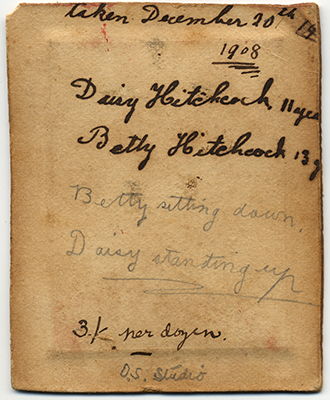
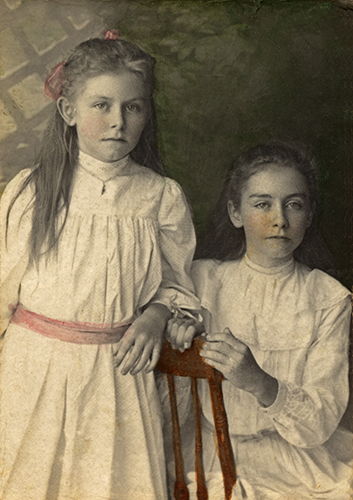
20.12.1908
Inscription:
'Taken December 20th 1908 Daisy Hitchcock 11 yrs Betty Hitchcock 13 yrs (Betty's writing?)
Betty sitting down. Daisy standing up (Daisy's writing?)
3/- per dozen D.S. Studio'
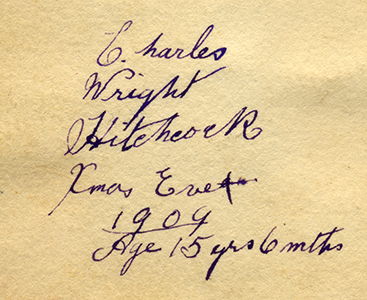
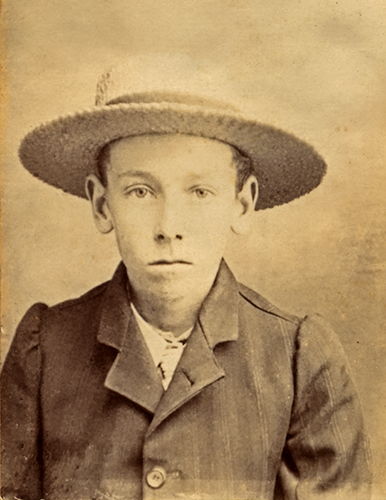
24.12.1909
Inscription: 'Charles Wright Hitchcock Xmas Eve 1909 age 15 years 6 months'
Purple ink - William Henry's writing.
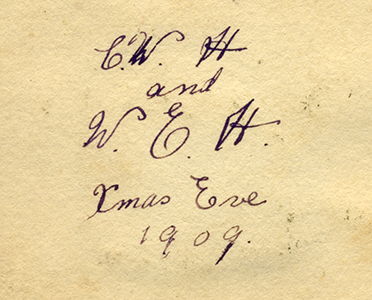
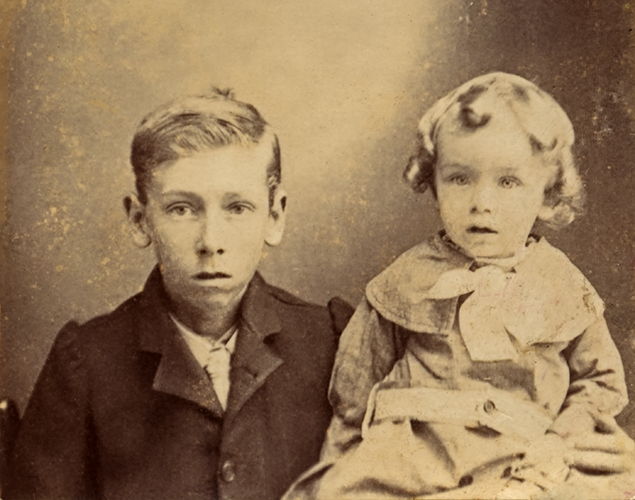
24.12.1909
Inscription: 'C.W.H. and W.E.H. Xmas Eve 1909'
Purple ink - William Henry's writing.
Charles Wright Hitchcock and William Edward (Ted) Hitchcock

Betty, Christmas 1910, age 15, DOB 1895.
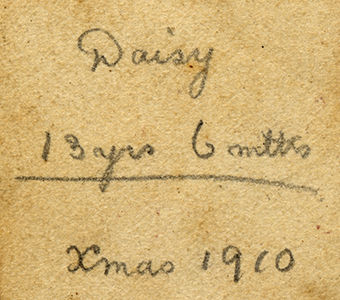
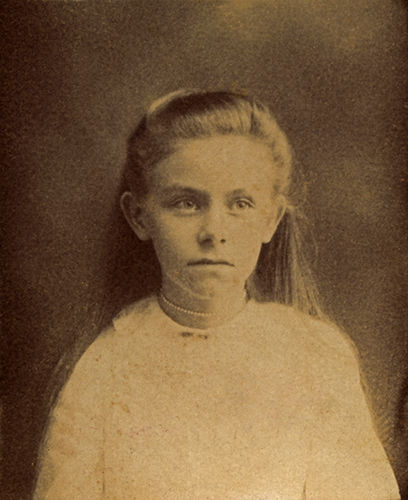
Daisy, Christmas 1910, aged 13 years 6 months, DOB 1897, looks like Bella's handwriting.
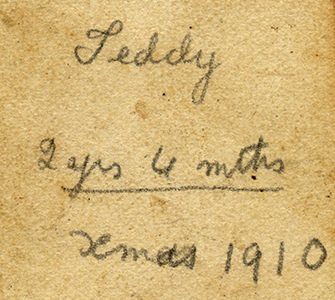
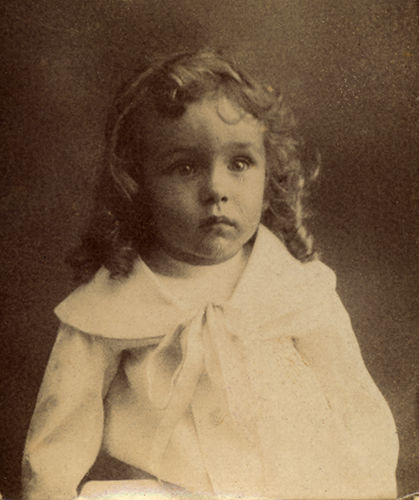
Teddy, two years four months, Christmas 1910, looks like Bella's handwriting.
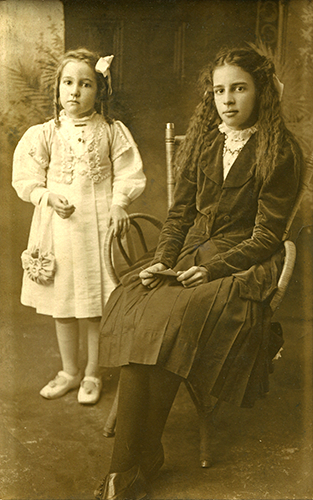
November 1911, post card.
Inscription: 'To Dear Mrs Hitchcock from Ruby and Audrey Hartley with Love'
(Bella's writing) 'November 1911'.
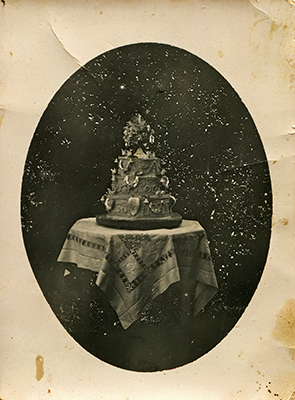
Wedding cake. A poor negative but printed on glossy paper in black and white, not sepia. Not similar to any other format of the Hitchcock photo set.
Madge said: 'The tablecloth was made by Betty or Daisy. The bush at the back could be the white rose bank, 10 ft high, 20 ft long, on Brookvale Farm.
Possibly Charlie and Millie's wedding cake?
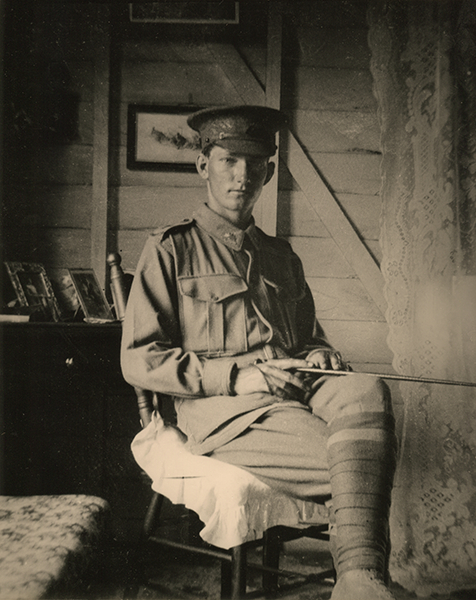
Circa 1914-15
Charlie in uniform to go to WW1.
Just before he was due to be embarked, he went for a walk with the family, there was a fig tree beside the road which used to be used by local boys to watch the picnic races.
He climbed the fig tree one last time. He fell out, and broke his wrist. It set badly, and he couldn’t go to war.
Photo lit by a window on the left which looked out on the front garden, which later had palm trees in it. Lounge room of Brook Vale.
In later years Charlie always had a wonky wrist.
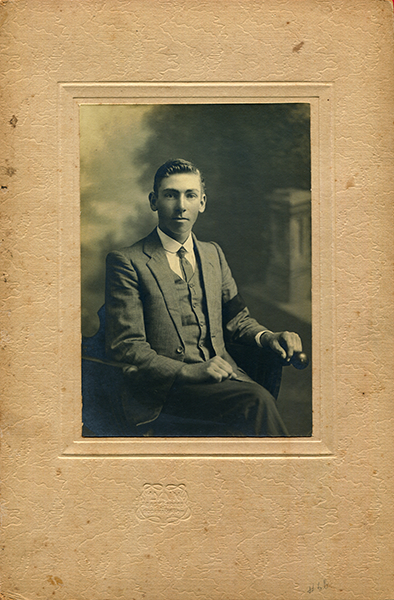
Studio portrait for Charlie's 21 st birthday. Photo dated 6th June 1915.
Note the black arm band.
As was usual in those times, the negative has been manually 'photoshopped' to improve the rendition of skin and eyes.
Photo by 'Lynn East Street Rockhampton'.
Inscription: 'I.E.Hitchcock Brookvale Tungamull E.P.R.
Daisy standing June 1914'
D.O.B. Betty 1895, Daisy 1897
Betty 19 yrs old, Daisy 17 yrs old.
E.P.R - Emu Park Railway? Betty’s writing. Printed as a postcard.
(left) Daisy, Charlie and Betty, circa 1915. Daisy is holding some rolled paper, an allusion to her passion and skill for watercolours of natural scenes.
(right) Daisy, Betty, Bella, Charlie, Ted, circa 1915.
The girls are wearing similar style dresses as in the photo from June 1914.
Ted, Charlie, Aunt Jessie Dunn, circa 1915.
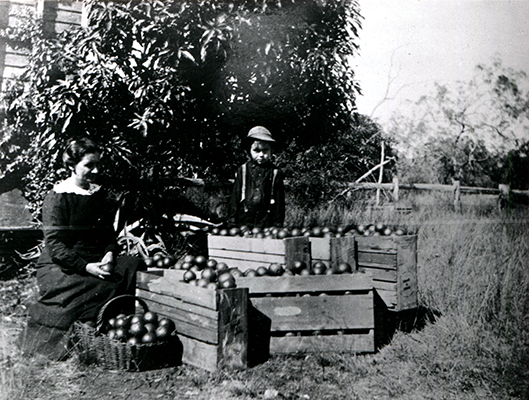
Circa 1915
Bella and Ted with oranges ready for sale.
When Will first started out he had vineyards. The crops were ruined three years in a row by hail. He then went into mixed farming, so if one thing failed he had something else to fall back on.
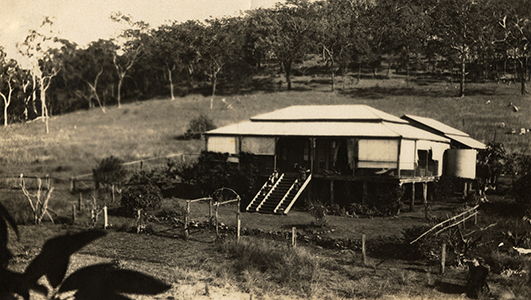
1915?
'Fern Hill' Tungamull (later Tarabah)
Charles William Hitchcock's home.
Taken from one of the (by this time large) mango trees which lined the drive. Child on verandah. Note bee hives in background.

1920s?
This photo also taken from a mango tree, at a later date than the above. Note the trees and vines have grown. Cars appear to be mid 1920s. Camera shake evident. Covered walk to right - toilet?
Madge's father took the buggy up the back where horses could graze when they visited. Car second from right is a 1924 Overland with a curved apron and transverse front spring. On the extreme left is a T model Ford cut down to a utility.
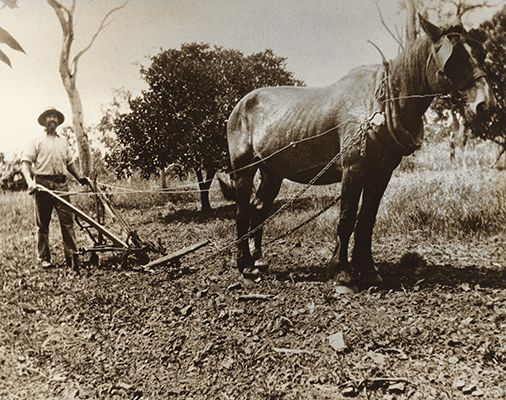
William Henry with his horse, ploughing/scarifying around his orange trees at 'Brookvale' farm, looking proud of himself.
It broke his heart when one day he found the horse down, in a gully.
Ca 1916 or later based on the horse.
(left) Will and Ted in the dray, circa 1916, at 'Brookvale' farm. Madge was not born yet.
However, later, Madge remembers this as needing two horses, not one as in this photo.
(right) Ted, Daisy, Bella, Betty in the buggy. Circa 1916.
(above left) Ted and Bella at Brook Vale. (above right) A face at the window. Circa 1918.
(lower left) This shows the galvanised iron extension from the kitchen with the stove in it, and a chimney. As well, there is a ribbed water tank and a 'boiler plate' type cubical water tank, with makeshift guttering leading from the verandah roof.
(lower right) Betty below, Daisy above. The vegetation has been amateurishly touched up on the negative before printing.
'Brook Vale' farm was about 90 acres, Will's father helped him to buy it, but conditions were always tough. Ted talked disparagingly of the house on the farm, calling it sarcastically 'the mansion'. He said he never willingly went back once he left it.
After Will died, the farm was sold. Family lore says that the new owners had not been in long when one day they left to visit friends, leaving a long piece of wood sticking out of the lit stove, and when they got back the house had burned to the ground.
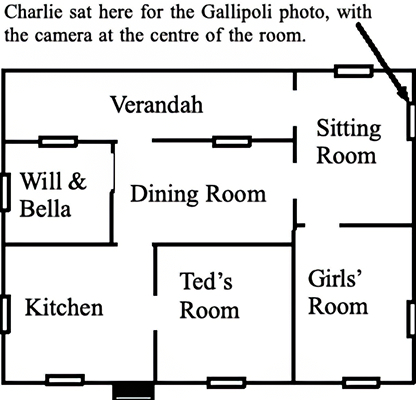
Plan of Brook Vale farm house.

Circa 1918
Daisy at the garden gate.
Madge said that the garden in her time was on the site of the former piggery.
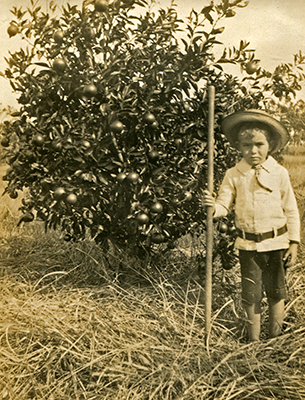
Ted in the garden at Brook Vale, beside one of the heavily mulched and well bearing orange trees.
He is in an interesting outfit. I wonder if he liked it?

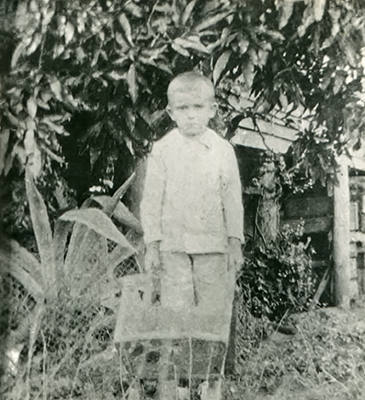
Ted in the garden at Brook Vale.
(left) Under one of the ubiquitous mango trees, with a wooden post and rail fence behind him. He is dressed up in a coat, shirt and tie.
(right) Close to the house, with a toy wheel barrow.
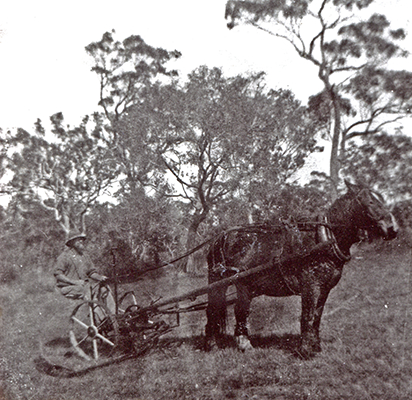
Circa 1918
William Henry on the grass cutter. (Very poor original. I don’t know who developed and printed Betty’s photos, but he should have stuck to digging ditches.)
The blade was toothed, with another which sliced off the grass. The blade could be raised and lowered with a handle on the left hand side. Big blade out the side. Steel bar with teeth.
Grass went in between, another blade went across and back cutting the grass off. The blade could go up in the air, presumably to go through gates and for storage.
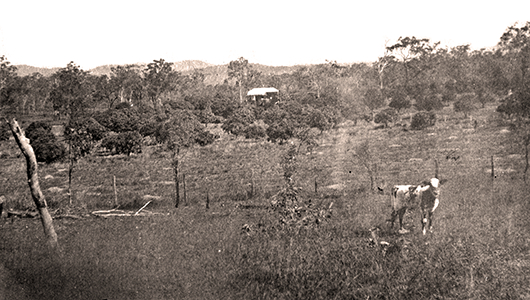
Circa 1915
Looking down the farm hill from where the first house was built by William Henry Hitchcock. It was built of bush timber, and was very small. Madge saw the stumps which were all that remained. It was about as big as a modern lounge room. There were only two rooms, a bedroom and a dining/kitchen room.
There were just the stumps and a mango tree left when Madge went up there.
This photograph gives a good idea of the general topography around the farm.
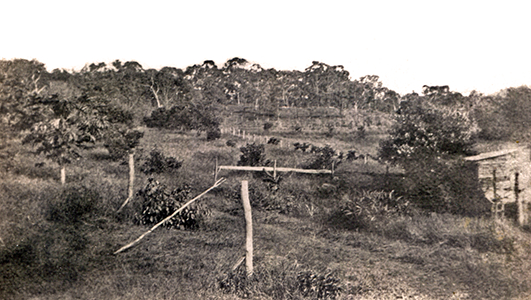
Circa 1915
Looking up hill to where the first house was, in the early stages, before Madge was born. The cleared land at the back became fruit trees also. Willliam Henry’s father, Charles William, gave him the land. He sold the land in between Fern Hill and Brook Vale to someone else - he possibly needed the money. Willliam Henry and Bella were annoyed about that, because it was good black soil flats.
Financially Madge thought they were poor, and they had a lot of drought. Madge used to go on foot or horseback to bring cattle in for milking. She had to ride up behind the old house, over to beyond the photo on the left and right. The boundary gate was on the left.
The family with Madge used to climb up the mountain range at the back with afternoon tea, then have afternoon tea looking out over the sea. Madge used to bring the horses in, riding a horse up the bigger mountain with the reins down, letting the horse find its own way. She caught yabbies in the dams.
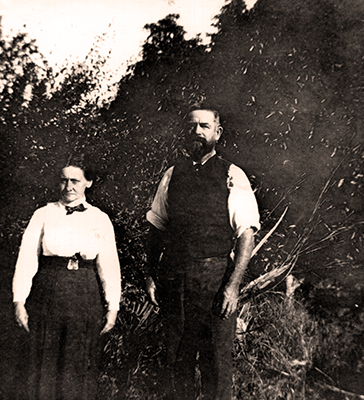 Circa 1918.
Circa 1918.
Will and Bella standing in the yard at Brook Vale.
Skirts got shorter later.
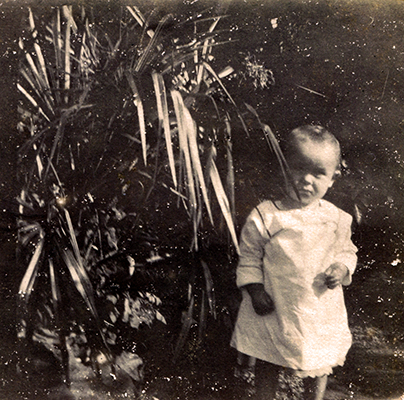
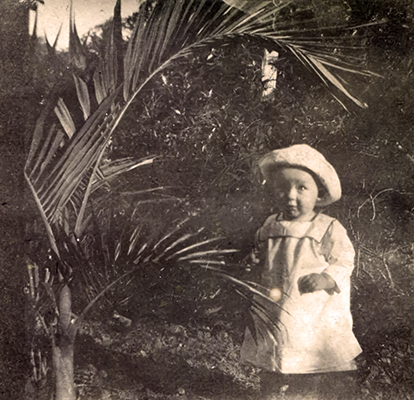
Circa 1918.
(left) Madge looks about one year old.
____
(right) From the same photo session, Madge beside young palms in the front garden.
The palms grew very fast. By 1932 they were above the roof of the house.
Photos by Betty.
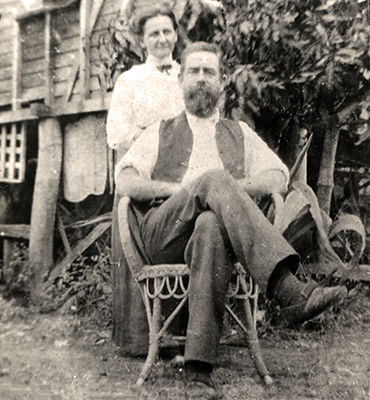

Circa 1918
(left) Bella and Will at Brook Vale. Will on cane chair from sitting room.
(right) WIll, Daisy and Betty.
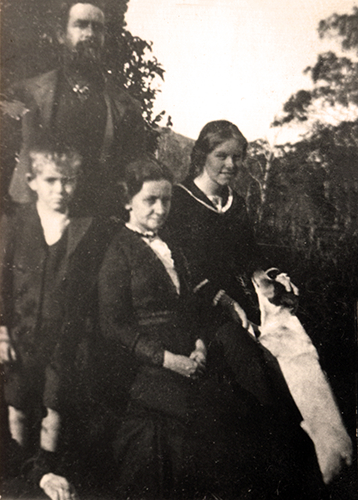
Will, Ted, Bella and Daisy with a dog in the garden at Brook Vale.
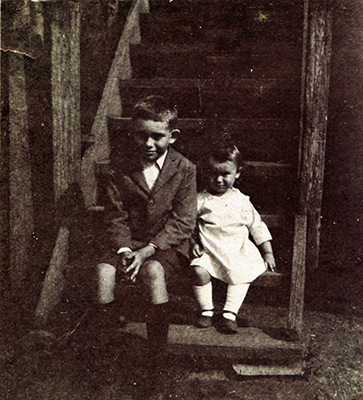
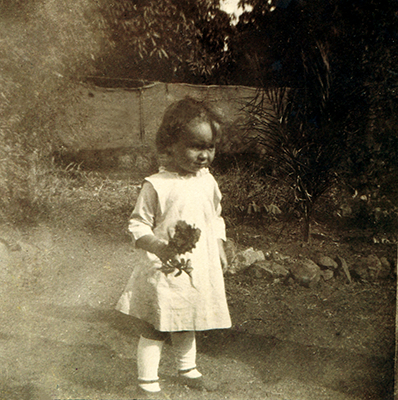
(left) Ted and Madge sitting on the steps at Brook Vale, circa 1919.
Madge looks about two years old, which makes Ted about 11 years. Taken by Betty.
Madge said that this was an unusual truce, as she and Ted fought like cat and dog while at Brook Vale. (They weren't on marvellous terms later, either!)
____
(right) From the same photo session, Madge with flowers.
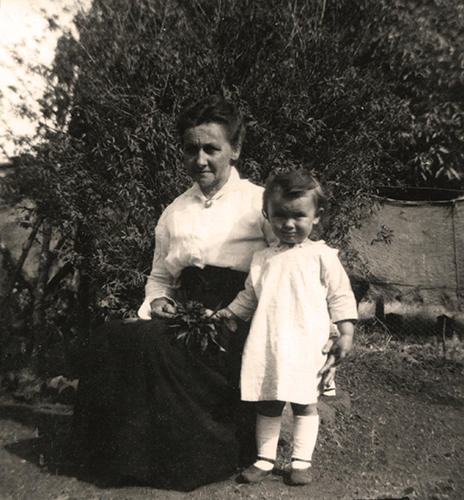
Bella and Madge, a lovely photo.
Hessian was used as a wind break around the garden. I wonder if it was recycled from some other purpose?
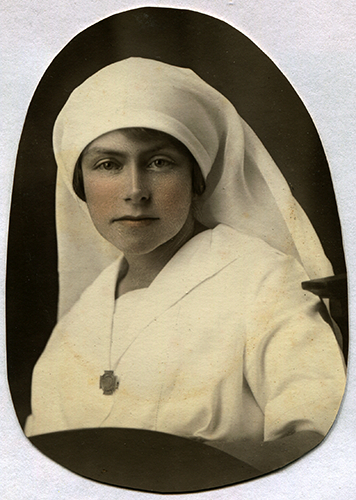
Daisy in her nurse's uniform, probably just after graduating.
The photo was cut to fit into an oval frame.
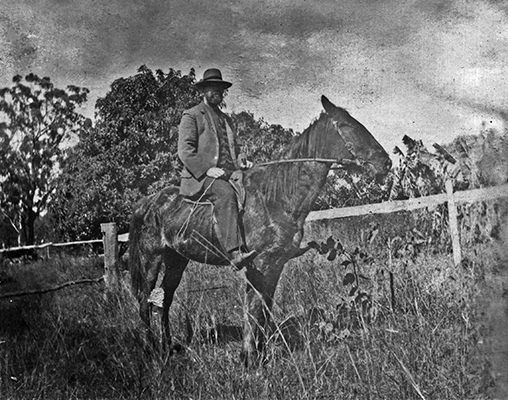
William Henry on his horse.
This horse and a cart were the only transport for the family.
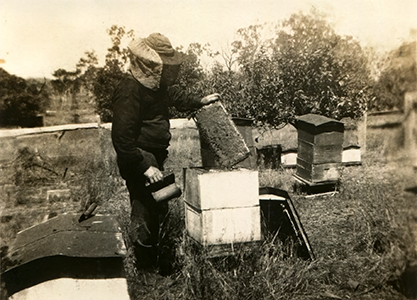
W.H. Hitchcock working his bee hives, inspecting what looks like a healthy frame of honey or brood.
He wears a veil on his head, and is using a smoker, but has dispensed with gloves. Many beekeepers become immune to bee stings.
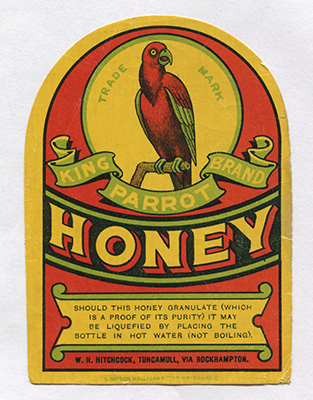
Family folklore was that W.H. designed this label for his honey.
However it looks more like a standard label which has been overprinted with the text 'W.H. HITCHCOCK, TUNGAMULL, VIA ROCKHAMPTON'.
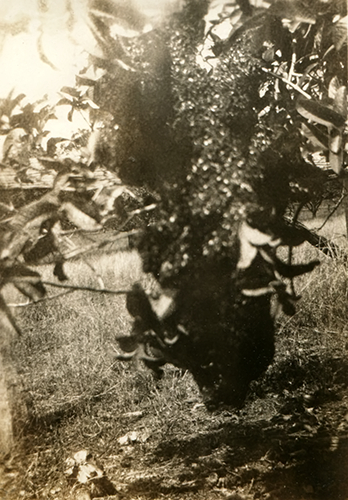
A swarm of bees. These were captured to increase the number of hives.
It is better to manage the hives by increasing the number of hives before they swarm, but if they do swarm unexpectedly, it is a bonus if they can be persuaded into a prepared, vacant hive.

Pawpaw at Brook Vale. Note the iron harrow leaning against the fence in the back ground.
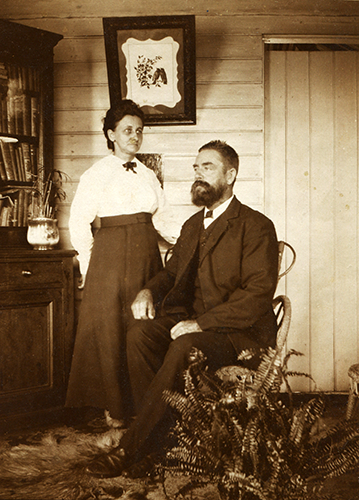
Bella and William Henry in the living room of their house.
Possibly an earlier photograph than that of Ted and WH below, though there is picture of birds on the wall, possibly painted by Betty.
Charlie was possibly the photographer. It is sharp and well composed.
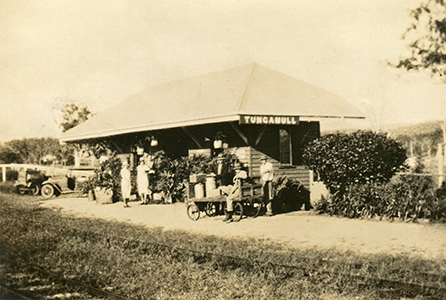
Tungamull Railway Station, two miles from Brook Vale. Six miles from Brook Vale to Keppel Sands, a total of eight miles.
When Ted was young he used to sit on the gate on the road to Keppel Sands not far from the farm at the weekend, and open the gate for the cars, and they would give him a coin for his trouble.
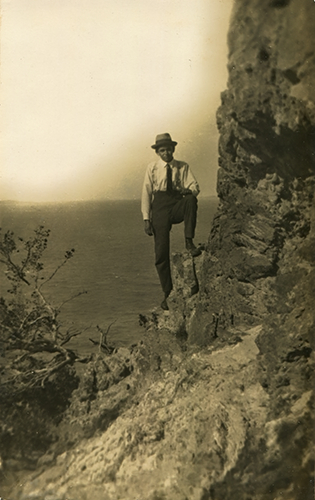
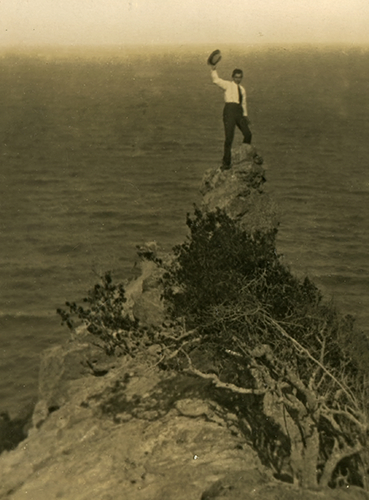
Ted at the beach in his Sunday Best as a teenager.
The family went to church on Sunday, then often went straight to the beach at Keppel Sands afterwards.
This is taken at Girt Island, which is about one kilometre off the beach at Keppel Sands, and is occasionally accessible on foot at very low tides. On the right Ted is on top of what is known locally as 'The Eagle's Nest'.
In the background are the trees of the coastline some distance away further north, near Emu Park.
The headland at Keppel Sands looks out to sea across sand and mudflats. There is no surf this far north, because of the influence of the Great Barrier Reef.
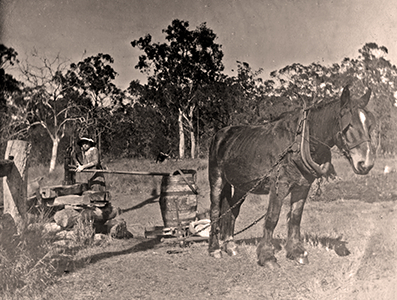
ca 1916
Daisy getting water for the house using a barrel and a sled dragged by the horse, before installation of the pump.
Note fencing wire reins on the horse.

ca 1920 (?)
William Henry, crippled by drought, got a mortgage to buy this brand new engine for a water pump, then was crippled by the mortgage. I think he would have been better off with a smaller and cheaper pump - they were available at the time. There seems to be no need for the wheels on this model, for example.
It was noisy. Madge remembered her father putting oil in it. The dark soil beneath the engine indicates that it sprayed a lot of oil. It solved the water problems, but in a bad drought he had to get in and deepen the well, which can be seen in the background. When deepening the well, Madge remembered going out to her father with morning tea, and seeing him down below breaking out rock, trying to bring in another stream of water. She sent him down his tea on the windlass.
Note that in this photo the hand pump is at the same level as it was in the photo of Daisy at the well before the engine was installed, at a convenient height for frequent use.
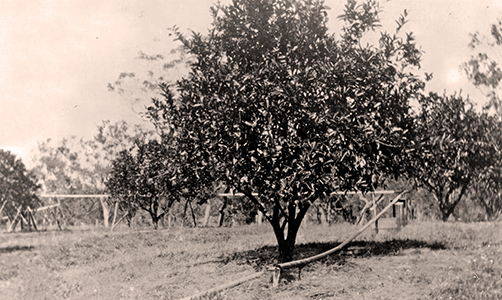
ca 1920 (?)
Water being delivered to the orange orchard. It looks like about 400 or more gallons per hour, quite a good flow. Will only had the one set of pipes, and Madge said it was hard and time consuming work. The galvanised iron pipes slipped into each other.
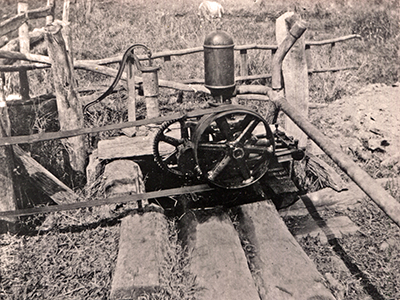
ca 1925 (?)
This is the pump at the well head driven by the motor above. The pump supplied water to the orchard and the house as necessary. Madge said that the spear pump (hand pump) was for animals in dry conditions. Note that the hand pump is now quite low down. I suspect that this photo was taken after Will had removed all the wood from the top of the well so that he could get in and deepen it during the drought. When he was replacing everything, there was no point in putting the hand pump in an elevated position as it would rarely be used.
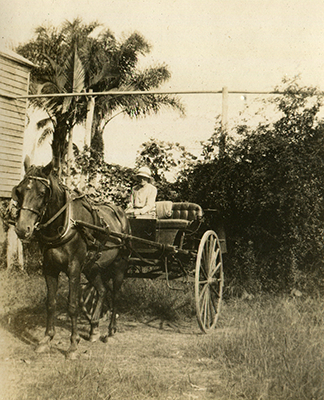
Daisy in the sulky.
Note the pipe to the house from the pump at the well, used to supply the tank when there was drought. The pipes just slipped into each other, rather than being a complete watertight fit, so they had to be elevated to reduce the pressure at the joints.
The sulky was bought so that Bella and Madge could go out together. Otherwise two horses were needed for the heavy buggy - though there are photos of it being drawn by just one. There is a big rose bush at the back, and the palm trees have grown tall.
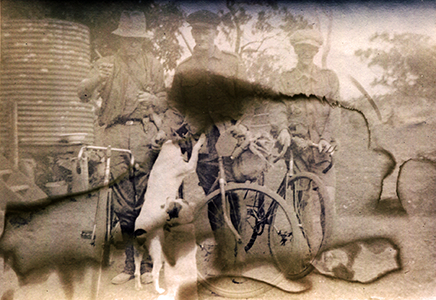
Ted, Bob, and Charlie Taylor going on a shooting expedition, taken near Brook Vale's back steps.
There was a shot gun on the farm, and Ted had his own rifle, which he used for shooting possums. He sold the skins for pocket money.
Bob and Ted went to school together. Bob (Taylor?) became a carpenter. Charlie Taylor got a job at the Public Curator in Rockhampton, and was transferred from there to Townsville.
Charlie Taylor attended to all the legal matters when William Henry died.

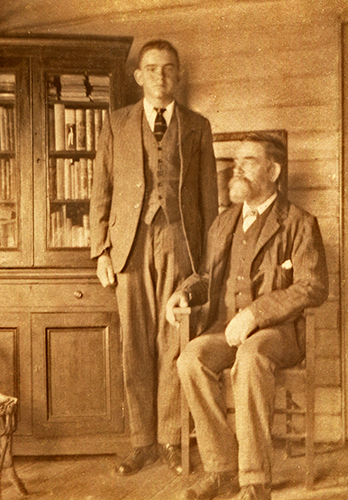
Ted and William Henry Hitchcock, his father.
By this time Ted had his own camera, and he has written in pencil on the back: 'To Betty From Ted. Show it to Daisy. I will send some more later.'
